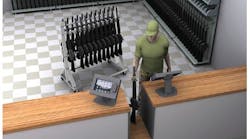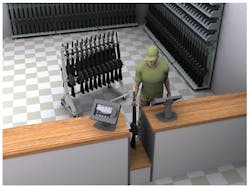The US Navy’s HERO certification is recognized as one of the most demanding and critical RF safety programs in the world. Thus, it is clearly impressive that test results have given RuBee (IEEE 1902.1) Auto-ID wireless tags, handhelds, and base stations a zero safe separation distance (SSD) on the HERO SAFE and HERO UNSAFE ordnance. In fact, Visible Assets notes that RuBee (www.rubee.com) is the first wireless technology to be certified by the US Department of The Navy with a zero SSD for tags, portable handheld readers, and base stations for HERO SAFE and HERO UNSAFE ordnance.
RuBee is based on magnetic fields rather than electric-field energy. As a result, the Navy had to develop a new magnetic safety-test protocol for fused ordnance under MIL STD 464C. Reportedly, those test protocols were based on worst-case scenarios with large safety factors. The results show that RuBee can safely provide real-time audits, accountability,
pedigree, diagnostics, and security to a range of explosive devices, ordnance, and munitions stored in sensitive locations around the world (see figure).
In this depiction, magnetic-based RuBee tags are used in check-in/out RuBee stations in an armory.
RuBee is intended to work on and inside steel as well as underwater. Its goal is to provide asset security and visibility in harsh environments, where electric-field-based technologies like RFID, WiFi, and ZigBee are unable to operate. RuBee wireless tags can be installed directly on or built into devices. They also can be combined with sensors to aid the diagnosis and management of maintenance schedules as well as the use and decommissioning of devices.
Other wireless RF-based technologies (like RFID, WiFi, ZigBee, Bluetooth, and Ultra Wideband) have tags under the HERO test program that may be safely applied to ordnance. But their readers or integrators typically have SSDs of 3 to 12 ft. Reading these RF-based tags may therefore become a risk near HERO UNSAFE ordnance. Report 8020/SER Q52/2250, "Hazards of Electromagnetic Radiation to Ordnance (HERO) Safety Evaluation Test Report for Near-Touching Use of RuBee (IEEE 1902.1) Base Stations with Ranger Antenna, 1T Tags, and pRap Readers in Proximity To HERO UNSAFE/UNRELIABLE Ordnance," is based on MIL STD 464C.

